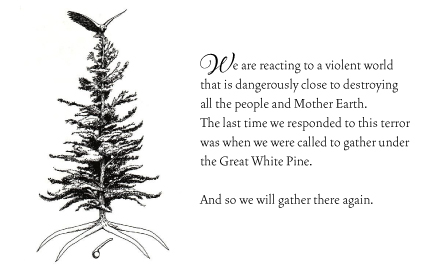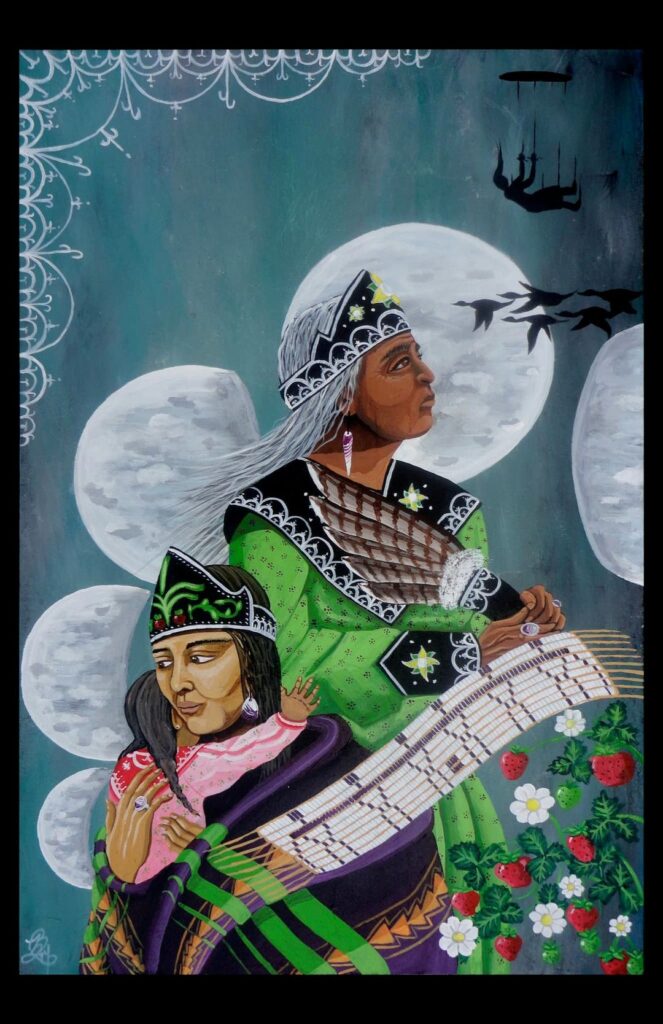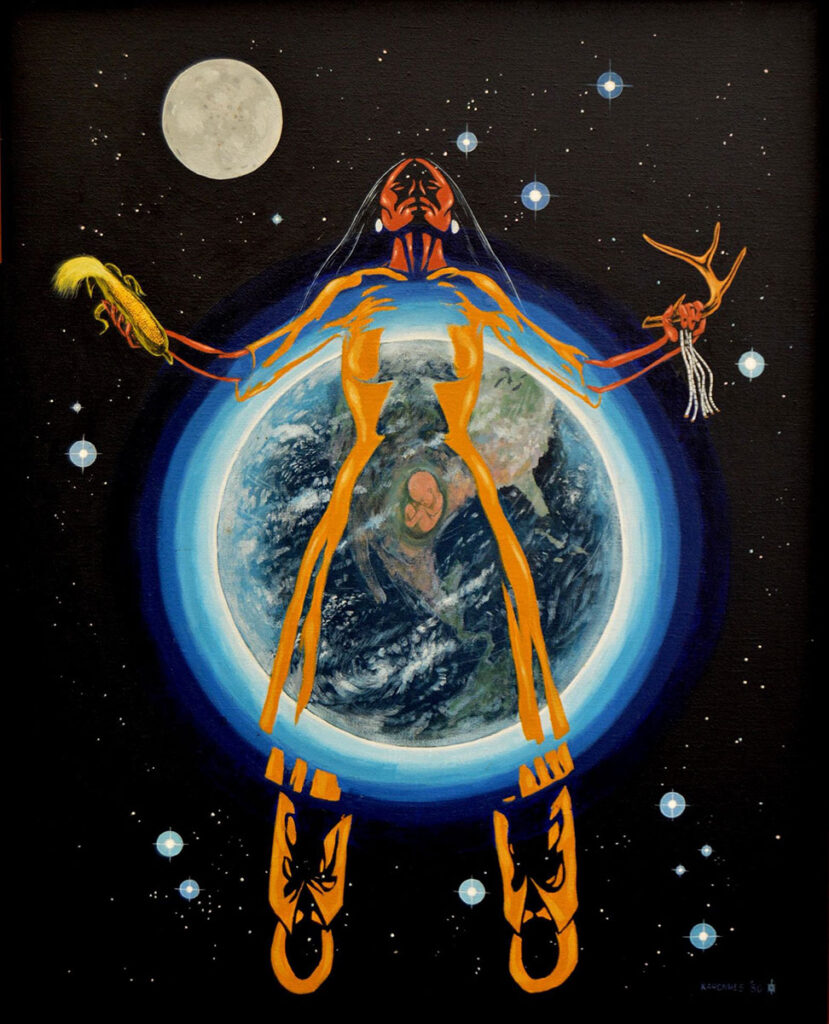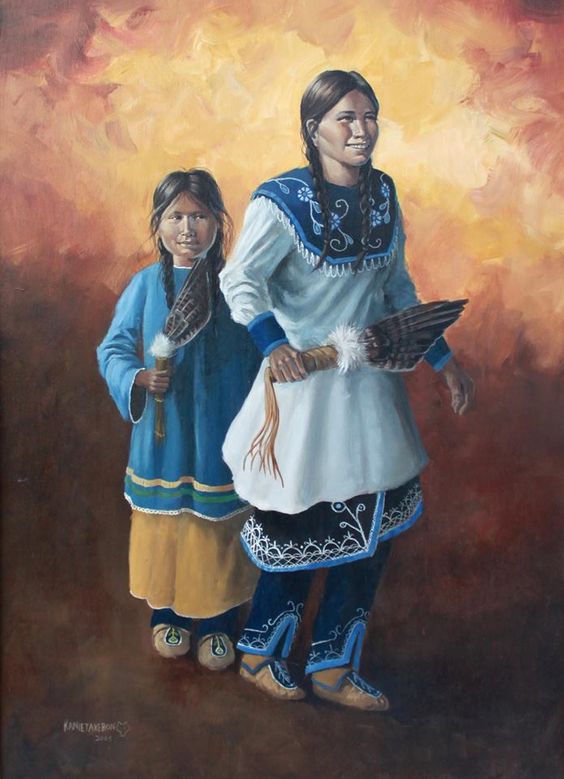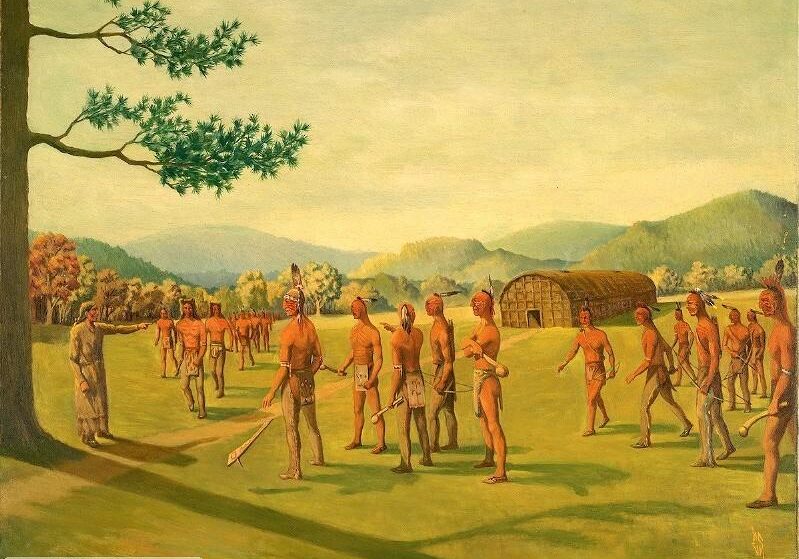
Tsiokonsaseh: A Story of Kononkwe (Women)
Jehkonhsaseh, Jikonsasey, Tsikuhsahsa, Tsikonsase, Jigonohsase, Jikonsase, Jigonsase.
"She would become the first "Jikonsaseh" with her name becoming the office of the Great Peace Woman, Head Clan Mother of the Nation. She would wear a cape covered with the fresh water pearls and these pearls would become a representative of Purity and Peace. This cape became a symbol of her office and position as the head of all Clan Mothers of the Confederacy. Women of re-knowned wisdom would follow in her footsteps at the House of Peace eventually established at Ganondagan. Most would be of the Wolf Clan and from the Wendat and/or Seneca nations. The last to hold this honoured office was Caroline Parker, whose brother Ely Parker was the last of the Grand Sachems of the Seneca. Today, as the nations are dispersed across Turtle Island, there is no one woman chosen from the people as a Great Peace Woman and her office stands empty."
A very condensed and short story of
Peacemaker, Hiawatha, Tsiokonsaseh and Tododaho
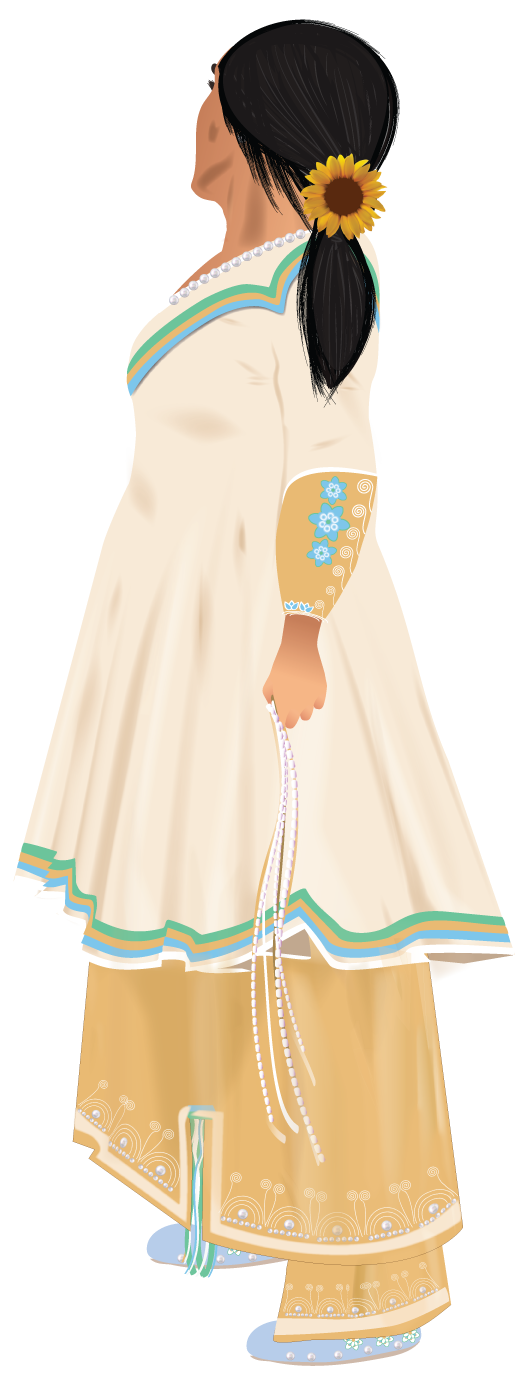
Important words before the rest...
Depth, length and capacities.
Great Law of Peace, introduction to Tsiokonsaseh.
This story is long, it is told for days and days and in very different ways by different people. But the story, like the Creation Story, no matter how it is told, is deep - loaded with Onkwehonwe lessons of morality, community mindedness, holistic objectivity, balance, original ways of knowing, and original ways of being. On this page you will only find a short story; it is not meant to replace, change or repute any other story. It is a beginner's path to encourage and inspire Onkwehonwe to learn more and better live in partnership with skennen/peace, ka'nikonh:riio/good mind and ka'kikonh:riio/encouragement/strength.
Fluidity and gender balance.
This story is fluid, there are many versions told by men; to my knowledge and through research and questions, I cannot find any woman who has told this story publicly. With the understanding that many Haudenosaunee are new on the journey of remembering our collective history, the only intention here is to make a short introduction being extremely mindful that the story is told in many different ways. It is best to listen to as many versions as you can.
In exploring this for the first time, it is important to keep in mind that originally (and to this day), the Haudenosaunee had no concept of ‘good’ and ‘evil’ because everything had to balance each other in order to be complete; the west sky balances the east, the Moon and Sun work hand in hand, winter’s cold balances with the summertime heat and most importantly, men and women need each other in order to achieve productive communities centred around equality and reciprocation. It is difficult here to write in the past tense as the knowledge and stories are usually told because the values and understandings still hold strong today; keeping the tenses as fluid as the stories is only so it is not read as if in the past.
The stories teach us these important reciprocal relationships, specifically in the Creation Story when the twins, Sapling and Flint were born; Sapling is East and Flint is West and they were meaningless without each other. As all children, they were different; one more subdued than the other. When they grew, they shaped Turtle Island together. Where Sapling placed calm, sparkling water, Flint threw rocks and mountains to make us stepping stones and waterfalls. It is also meaningful to remember that the people have an understanding that spirit is different from soul and that after a lifetime, one can choose to return to Mother Earth and take different forms; reincarnation was/is a reality for us.
Language.
We acknowledge that the stories should be told in the language of the ancestors but since many of us have been (temporarily) robbed of our traditional voices we tell the stories in the new language of English. This way we are inclusive to all of the descendants and survivors, and hold hope that people will unpack incentives to recapture our original ways of speaking to each other and to our relations of the natural world. Only when we learn the language, will we better understand the story. Until then, we do our best.
Stories and possible timelines.
Our most significant stories come from several different cycles in time, or epochs as scholars might call them. The story of the Great Law of Peace takes place well after the Great Tree in Sky World was uprooted and a curious Sky Women fell (or was pushed) through the hole and down towards a world of water and onto the Turtle’s back. It takes place after the life of her grandson Sapling has ended and he has traveled back through the Milky Way to Sky World. This story sees Mother Earth in an era of horrific wars between the nations; some say Sapling sees this bloodshed from above and is called back to bring peace to the Haudenosaunee. He takes the form of Peacemaker and returns with a detailed construct of peace that included all of the people coming together cooperatively, equally carrying good mind, under a 'black sun'. Peacemaker would share this strategy across the nations and he knew to accomplish this he must seek out speakers; a woman to address the women and a man to address the men. This version differs notably to others in that some storytellers do not connect Peacemaker, Hiawatha or Tsiokonsaseh to the previous epochs but tell the story as a new time with new people. However you learn, listen to all variations because it is ultimately up to you how you learn and most importantly, it is up to you how you take the lessons of the stories and apply them to real time growth and learning.
A very condensed and short story of
Peacemaker, Hiawatha, Tsiokonsaseh and Tododaho
Approximately 1000 years ago (the year of 909 or 1142, depending on the scholar and storyteller) was a time of Great War among eastern woodlands peoples. Near Kenhteke (Tyendinaga) along the shores of Kaniatarí:io (a nice lake/Ontario) a mother called Kahehtó:kta takes her daughter Kahehtí:sak far away to live safely from the bloodshed. She becomes pregnant but because of their remote surroundings, they cannot determine who the father is. Her mother believes that the baby is a risk to their safety and tries to kill him 3 times, but he cannot be killed. This child is special and carried a special message for all the nations, eventually the women named him Tekanawí:ta (also known as Peacemaker). As he grows into a man, Peacemaker teaches the people many lessons including the four sacred ceremonies (Ostowako:wa/Feather Dance, One:ron/Drum Dance, Atonwa/opening/welcoming of names and Kaientowa:ren/Peach Bowl). As a young man, Peacemaker launches his stone canoe off the shore to begin his long journey to meet all the people and spread the word of peace.
At this time, there was a woman who lived in a long lodge and corn camp on a path at the edge of the woods, between the warring nations. As was traditional for Haudenosaunee women, she always had food ready to feed anyone who might wander by. At this time of violence and conflict, she found herself feeding and sheltering the warriors. Day after day a new warrior would come and rest there, then they would move on. She kept her door open to the visitors and only asked one thing of them, to leave their weapons outside.
One day the young man Peacemaker came to her door and and he told her of his peace proposal, asking her, “stop feeding the warriors”.
She replied, “Hunger does not stop anger. Going forward, each one who visits here will be told of your Great Law of Peace and that will make change. Yours is a beautiful vision and I believe in that beautiful mission. I will help.” For a long time, she continued to spread the word and thought about the structure, strategy and concept of this new agreement that Peacemaker spoke of.
At that same time, a grief stricken man named Hiawatha (Aionwathá),(who was Onondaga living with mother and wife's Mohawk family) suffered intense pain and retreated from the districts of war. Near death with grief after his wife dies, Hiawatha also loses his daughters after Onkwe Ra'war:roks (later named Tadodaho, the most vile of violent leaders) lured them all to their deaths. Hiawatha suffered, he could not eat or sleep, he walked and walked in his misery with no will to live. He knew of the Peacemaker but lost his way on the journey to peace. One day, he found his reflection in a nearby lake and saw his own endless stream of tears dripping down and into the water. The ducks saw his grief and knew that if they flew up in the most powerful manner, that they could give Hiawatha the gift of condolence and peace, and so they did. They flew with such might that the waters retreated and left in the sandy dirt were shiny purple and white shells, Onekor:ha (Wampum). With the purity of these white and purple shells, Hiawatha wiped his tear stained eyes, cleared the memory of screams from his ears and cleaned his mind of the debilitating grief; his process of healing is now known as the condolence ceremony.
Peacemaker knew this man from his travels and alongside him, Hiawatha walked from nation to nation to unify the leaders of each and in the end they gathered together under one longhouse. Hiawatha carried the wampum and had the power to console the grief of the people caused by the devastating loss of life. They were gradually becoming United Nations, peaceful nations.
But there was only one person left for them to touch with kindness and that was the same man who murdered Hiawatha's daughters. The Onondaga tyrant who lived in the swamp, Todadaho with snakes in his hair was the most tormented and wickedest spirit left to join them. No one had been able to calm him, he murdered everyone, was known to be a cannibal and used bodies as decorations. Here we must remember that everything was understood to balance and it takes remarkable people to see and reveal that Todadho had only buried his love for kindness and peace; it still existed. Hope and balance.
Peacemaker sent for the woman from the long lodge on the edge of the woods, and she came. She brought with her a vision of a constitution of peace. They collaborated and negotiated on the sections of the democratic structure and established the three principles as 1) Skennen/Peace, 2) Ka'nkonh:riio/Good Mind and 3) Kashatstenshe:ra/Strength, Competency and Capability. They presented to leaders the sacred will of the people in absolute unity and all were in agreement. Her name was Tsiokonsaseh (Jikonsaseh/Jigonsaseh), ‘Peace Mother’ and she took office as ‘Mother of Nations’, ultimately becoming the decision maker and the law of the Onkwehonwe; the absolute source of conflict resolution to over 13 nations. Tsiokonsaseh also brought with her a song that she was taught by the birds and she taught it to all of the leaders.
Gently, Tsiokonsaseh, Peacemaker, Hiawatha and many leaders approached Tadadaho's bloody swamp, they were singing that birds' song in a united voice. At first, he didn't hear the song, he had lost his ability to hear the birds. They repeated the song over and over. He fought his feelings and squirmed in resistance, but the song lured him from the swamp. Tsiokonsaseh calmed him and as a mother does, she only sees a little boy who suffers and has not yet escaped his demons. She comforts him and he lets her come closer, she touches him and while singing softly, she wipes the tears from his eyes so he could see clearly, wipes his ears so he could hear the birds again, gives him water to remove the pain of grief from his throat and finally she combs the snakes from his hair; the snakes fell out one by one.
His last tormented tears fell and he inhaled as if just learning to breathe again. He was finally able to understand calm and his mind became filled with peace. Tsiokonsaseh, Mother of Mothers, then gently placed an antlered gustowa on his head and elevated him with the new title of Chief of all Chiefs promising him that Onondaga would be the central fire of peace for all eternity.
The story continues under the Great Tree of Peace in the capital of Ganondagan where the warriors symbolically buried their weapons and shared the smoke from the pipe of peace. Peacemaker's prophecy of a 'sign in the sky' turned out to be the time of ‘Black Sun’ when Grandmother Moon, in all of her femininity passed in front of our Brother, the Sun; a celestial event that we now know as the English words, solar eclipse.
Meeting love inspires caring and protecting; that inspires peace and healing.
We call on her now
Retelling, Restoring, Rematriating
Tsiokonsaseh or Jikonsaseh or Mother of Nations / Peace Mother was Peacemaker's collaborator and the first woman/kononkwe to share the message of peace. She was a direct descendant of Sky Woman, the origins of our matrilineal society. As the Mother of Nations, Tsiokonsaseh continued that structure where women were the sole counsellors or law at a grassroots level of government, the keepers of peace, keepers of the earth and keepers of lineage and names. The agreement included three acting principles; sacred will of the united people, high ethics and public health.
In this system, Clanmothers were responsible for nominating chiefs and they could dehorn chiefs. They led survival by fair delegation; each member of the community contributed equally to a well run, reciprocal and productive society; women serving longhouse politics, family, community, ceremony, medicine and farming, men serving the forests as caretakers and hunters. The positions of physical labour were most certainly shared between the genders.
Jikonsaseh established Haudenosaunee/Hodinöhsö:ni' society as matricentric. That is, centred upon the mothers. Each longhouse was run by the matrilineal lead alongside of her sisters and daughters, all married couples lived in the wife's mother's house. Clan mothers also held and appointed all of the names for all of the people, they kept the records and made sure that no names were duplicated; a task that is attended to to this day. Generally, men were away and returned to present the community hunting harvests and to attend seasonal ceremonies. We see this especially clearly at midwinter time when the men have been gone for 3 moons and return to the longhouses heavy with food and fur; uplifting the spirits of the community just when survival seemed uncertain and hope was dwindling.
Collectively, women were the overall caretakers of the longhouse economy; managing the houses, the meat and fur distributions, farms, the harvests and held the political capacities - never forgetting the value of the men, the communities and families maintained peace and upheld equitable perspectives of gender.
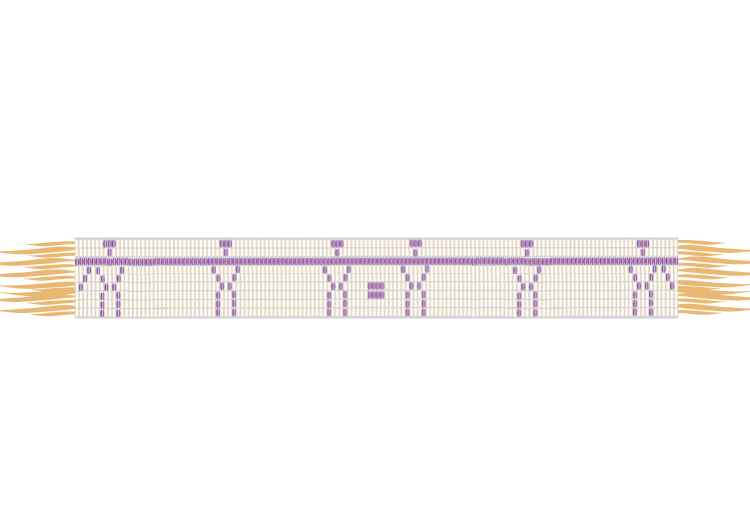
Women's Stories, Women's Voices
The stories of Tsiokonsaseh evolve as fluidly as the storytellers and historically, even among our own Haudenosaunee nations, the storytellers were often men. In the oldest retellings of the wampum codes, we are told that both Hiawatha and Tekanawí:ta/Dekanwideh made their journeys to the tribes with the "Great Mother," Jigonsaseh and consulted her in every important detail." Without her approval, Peacemaker's plans for the peaceful confederacy could not proceed. She was sacred to her people, her word was law and her sanction was necessary in all political matters of inter-tribal importance. She was known as the mother of all Onkwehonwe, a direct descendant of Sky Woman and was upheld for serenity and natural way of creating peace and gentle spaces. It was told that if two angry bitter men came to her door ready to kill each other, they left in brotherly love; this was her magic.
In other stories, she was a homely woman who lived alone at the edge of the woods and invited warriors in, fed them, heard their stories and pitted them against each other to increase the violence. It is told that she encouraged war; in this version, Tsiokonsaseh is vilified and even represented as a witch and a prostitute who often poisoned the warriors - she knew all about the medicines. The most common story told today is that Peacemaker warned her to change her ways and walk with him on a journey to peace; that he would 'save' her from her own evil. But this version is new and hauntingly similar to many Christian projections. Research shows that the stories written prior to 1820 saw her as a trusted judge and counsellor to more that 13 nations. Many women will interject here to comment on the fact that the villain version of the story is likely told by men (both settlers and Onkwehonwe) because not many women would ever consider publicly promoting a story of a war-loving prostitute and murderer at the edge of the woods who fed the fires of violence and warfare.
Since the saltwater people washed onto the shores of Turtle Island, the visitors to our communities were curious pale men who interviewed our Mother appointed chiefs and collected our knowledge of celestial, earthly and cultural ways of knowing. Clergy, anthropologists, scholars, all men. With this awareness to gender influenced recordings, we are awakened and increasingly mindful of the origins of stories we've heard, read and even studied. The learners who left our villages took their notes to other men, the other men translated/edited/corrected/rewrote and then shared them with male colleagues and students. We are all painfully aware that historical accounts in text books do not always align with our cultural truths.
Before contact, we know that Haudenosaunee ways of being were highly gender balanced, honouring both males and females as equal contributors in relationships and community health. When the stories were paternalized, the foreigner perspective of Indian country was born and subsequently we became a dramatically altered culture.
The omission of maternal voices and stories results from internalizing patriarchal constructs and those constructs were fed into our minds by visitors from across the big waters. The perspective infected everyone in our communities regardless of gender and were the very foundation of our social dysfunctions thereafter. And deeply in the pockets of those patriarchs was the strategy and execution of absolute genocide because
we. just. kept. surviving.
Our kayanerekó:wa was interrupted by grotesque violence over land 'ownership', forced segregation of our people to 'reserves', introduction to highly fatal illnesses, changes in our food / nutritional sources, an introduction to poverty and alcohol, destruction of the family as a result of the residential school systems, sixties scoop, forced sterilization of women, incarceration and overall displacement/assimilation strategies
and we still. just. kept. surviving.
Tsiokonsaseh's story is a woman's story; it asks to be recaptured and retranslated by feminine voices.
Her story asks to be retold to women, by women. Her story needs to be told to the girls. It is time to rematriate her.
Because as much as the Peacekeeper is honoured for initiating international peace, Tsiokonsaseh carried inside her the great gift of uniting people, of healing hearts and creating safe spaces. With a forever fire and food warming over it, everyone was welcome to lay down their fear and ferocity and become of good mind and if they couldn't, she could simply touch them and transform their anger to love.
A woman of wisdom, and with the respect of all mothers, her word became law and the law lives on through the hearts and spirits of our clan mothers today.
We call on Tsiokonsaseh to walk with us while we reclaim peace and equality.

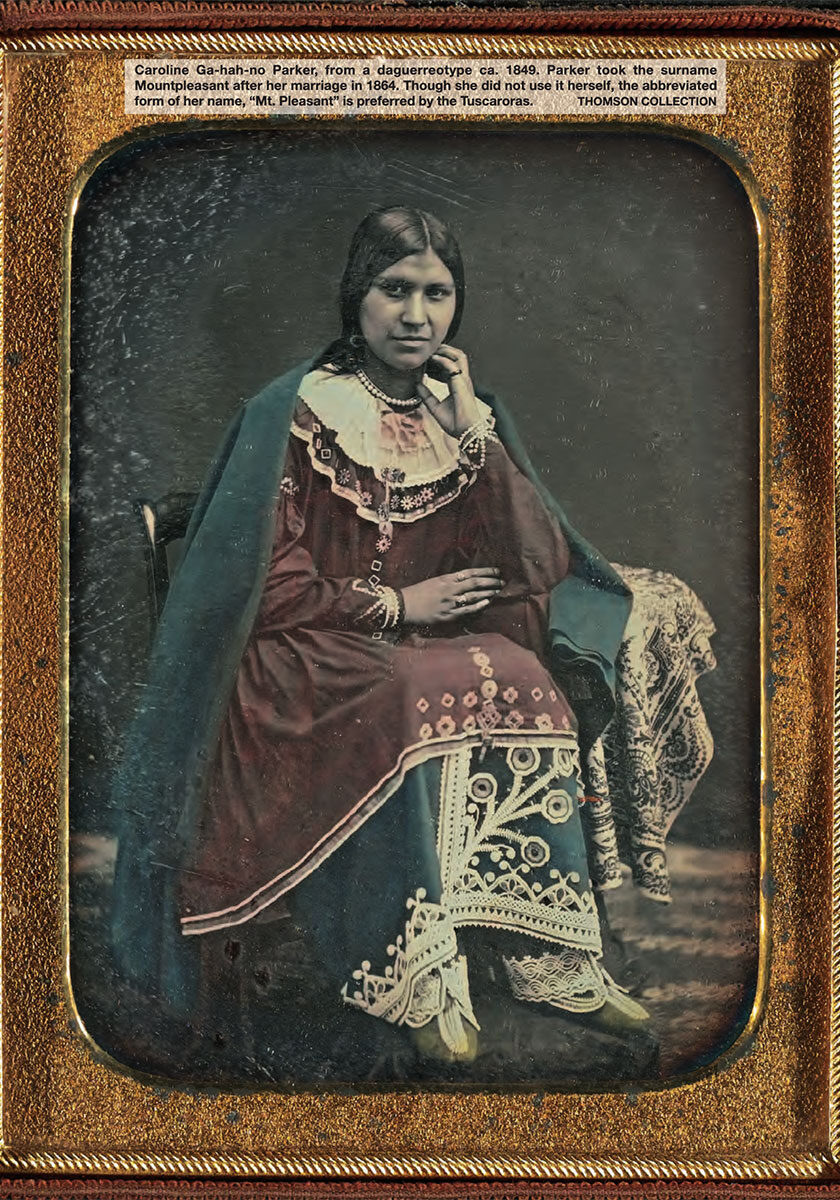
Caroline Parker
We begin with Arthur Caswell Parker who was born on the Cattaraugus Seneca reservation in 1881. He was educated in the reservation school in White Plains, N.Y., studied anthropology at Harvard and then was Curator of Anthropolgy in the American Museum of New York. We begin there because this might be the first instance of any Haudenosaunee man sharing the life, lineage and ceremonies of the Indian people on any written, authentic, academic level; making his records vital to Haudenosaunee communities even if the colonizers' influence bled into his ancestral and childhood experiences. He had several publications and as we uncover them, they will be added to our resources page.
Arthur's father Frederick is a son of Nicholson Parker, Secretary of the Seneca Nation. Nicholson Parker was brother to General Ely Parker who was a military secretary when her wrote "The League of the Iroquois."
Arthur Parker's mother was Geneva Griswold (Scottish and English), a teacher at the Allegany and Cattaraugus reservations.
Arthur Parkers great great grandfather was Handsome Lake, the Seneca prophet. His paternal grandfather 6 generations back was Old Smoke (Gaiengwatoh), leader of the Senecas, Wyoming, PA.
Pictured is Caroline Parker. The great grandmother of Arthur Parker was Elizabeth, a direct decendant of Jigonsaseh, "The Peace Queen and Mother of Nations". Parker's sister, Caroline was given the name, Jigonsaseh through her matrilineal line and she was the wife of Chief Jon Mountpleasant of the Tuscaroras. Tsiokonsaseh, the Peace Queen, is thought to be a descendant of Sky Woman and was the Mother of Nations who walked with good mind alongside of Peacemaker (Dekanawidah)and Hiawatha in the movement known as the Great Law of Peace.
Again, we begin with Author Parker because in his 1919 writings of "Last Grand Sachem of the Iroquois and General Grant's Military Secretary", he writes biographically of his great uncle Ely Parker, of Jigonsaseh, Indian tradition and ceremonies. He writes of his boyhood on the reservation, how a sachem becomes a warrior, the bones of Red Jacket, Indian dances, the character of an Indian, Iroquois adoption, wampum and many other valuable pieces of Haudenosaunee history.
The office of Jigonsaseh/Jikonsaseh/Tsiokonsaseh is still vacant.
This is not a comprehensive list of images, language or research. Nor are the stories or descriptions written by scholars (with the exception of cited research links). This site is meant to be general information and condensed stories for those who are interested in beginning their learning journey and/or seek a better understanding of the 2024 eclipse and the matrilineal ways of the Haudenosaunee. You may also find spelling and language discrepancies, please encounter them with an open mind to the fluidity and complex nature of our dialects and language.
At the time that we joined together to ratify the Kayanare(n)kówa (Great Peace), some say that a total eclipse darkened the skies so deeply that the nocturnal animals woke to encircle and witness the calm of the people who unified under the Great White Pine. As our brother the Sun re-emerged from behind the kindness of Grandmother Moon, all Onkwehonwe were awakened with a new sense of balance and unity and we intend to walk in unity until the end of time.
Some kononkwe (women) are weaving the significance of the eclipse at the time of Kayanarekówa into the one that happened in 2024. In this world of war, we are reminded of the monumental role that Peace Mother, Tsiokonsaseh played in establishing unity, equality and peace among the nations.
We are calling in peace now and we are elevating Peace Mother and our voices to call for reunification.
Foundational to Haudenosaunee identity is the transmission of feminine knowledge, social structures and diplomacy and we have found a time and place to recapture that way of understanding; under the sky, hand in hand, in song and in a display of effeminate matrilineal power.
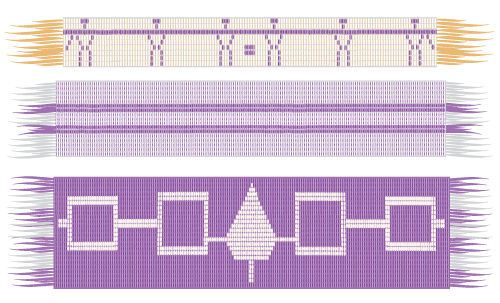
"Woman is the first environment. In pregnancy, our bodies sustain life. At the Breast of women, the generations are nourished. From the bodies of women flows the relationship of those generations both to society and the natural world. In this way the earth is our mother, the old people said. In this way, we as women are earth"
Katsi Cook, Mohawk Midwife, Akwesasne

